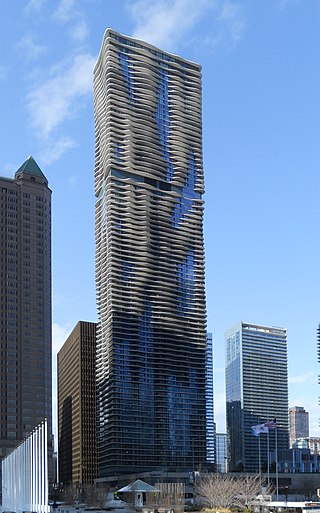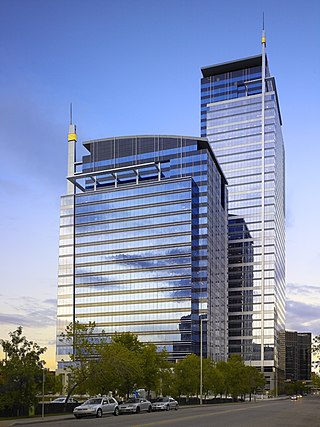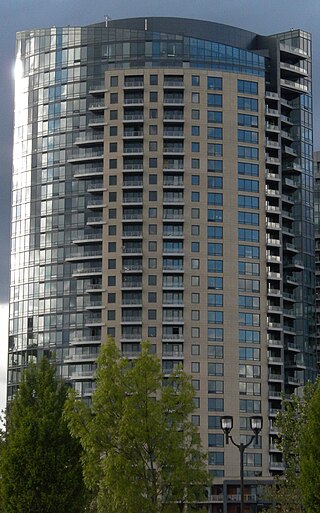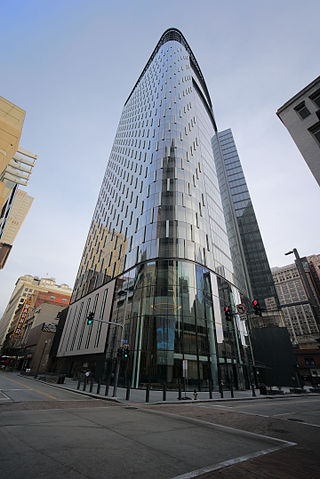
One Boston Place, also known as the Boston Company Building, is a 41-story office tower located in the Financial District of Boston, Massachusetts. With a height of 601 feet, One Boston Place is the 7th-tallest building in the city. Despite its simple appearance, One Boston Place has become a major Boston landmark due to its distinctive diagonal exterior bracing and unusual rooftop "box" design. Completed in 1970, the skyscraper has served as home to several law, financial, real estate, and corporate firms. Bank of New York Mellon is currently the primary tenant of the building.

1180 Peachtree, commonly known as the Symphony Tower, is a 41-story skyscraper located at 1180 Peachtree Street in the Midtown district of Atlanta, Georgia, United States. Rising to a height of approximately 657 feet (200 m), the building includes office and retail space in its 624,996 sq ft (58,064 m2) of floor area as well as a 1,200 space parking deck. Construction was completed in 2006.
Bruce Bunji Kuwabara, is a Canadian architect and a founding partner of the firm KPMB Architects. He is an invested Officer of the Order of Canada and recipient of the RAIC Gold Medal. He is Board Chair of the Canadian Centre for Architecture in Montreal.

Brookfield Place is an office complex in downtown Toronto, Ontario, Canada, comprising the 2.1 ha (5.2-acre) block bounded by Yonge Street, Wellington Street West, Bay Street, and Front Street. The complex contains 242,000 m2 (2,604,866 sq ft) of office space, and consists of two towers, Bay Wellington Tower and TD Canada Trust Tower, linked by the Allen Lambert Galleria. Brookfield Place is also the home of the Hockey Hall of Fame.

Eighth Avenue Place is a 1,850,000 sq ft (172,000 m2) twin-tower building complex located in downtown Calgary, Alberta, Canada. The complex includes a 49-storey 212 m (696 ft) East tower, 40-storey 177 m (581 ft) West office tower, and a three-storey indoor urban park.

Aqua is an 82-story mixed-use skyscraper in Lakeshore East, downtown Chicago, Illinois. Designed by a team led by Jeanne Gang of Studio Gang Architects, with James Loewenberg of Loewenberg & Associates as the Architect of Record, it includes five levels of parking below ground. The building's eighty-story, 140,000 sq ft (13,000 m2) base is topped by a 82,550 sq ft (7,669 m2) terrace with gardens, gazebos, pools, hot tubs, a walking/running track and a fire pit. Each floor covers approximately 16,000 sq ft (1,500 m2).

Centennial Place is a building complex located in downtown Calgary, Alberta, Canada, which includes a 39-storey 182.6 m (599 ft) and 23-storey 165.2 m (542 ft) office tower.
Perkins&Will is a global design practice founded in 1935. As of 2022, Perkins&Will had 28 offices and over 2,500 employees. In the same year, Perkins&Will generated $572.47 million in earnings, making it the second largest architecture firm by revenue in the United States. Phil Harrison has been the firm's CEO since 2006.

The Pinnacle at Symphony Place is a 29-story, office and retail skyscraper located in Nashville, Tennessee, in the city's SoBro district. Located adjacent to the Schermerhorn Symphony Center, the building officially opened on February 10, 2010. The building includes 520,000 square feet (48,000 m2) of Class A office space and 23,000 square feet (2,100 m2) of retail space.

The Ardea, formerly 3720, is a 30-story 99.06 m (325.0 ft) apartment skyscraper in the South Waterfront district of Portland, Oregon. The building was completed in March 2009, however was turned over in phases allowing occupancy beginning in August 2008. The Ardea was developed by Gerding Edlen, designed by GBD Architects, and constructed by Hoffman Construction. The building was initially designed to be a condominium building but was converted to apartments after the Portland housing and condominium supply outstripped demand. The Ardea joins John Ross Tower as the seventh tallest building in Portland.

Fentress Architects is an international design firm known for large-scale public architecture such as airports, museums, university buildings, convention centers, laboratories, and high-rise office towers. Some of the buildings for which the firm is best known include Denver International Airport (1995), the modernized Tom Bradley International Terminal at LAX (2013), the National Museum of the Marine Corps near Quantico, Virginia (2005), and the Green Square Complex in Raleigh, North Carolina (2012).

F5 Tower is a 660-foot-tall (200 m) skyscraper in Downtown Seattle, Washington. It consists of 44 floors and is the sixth-tallest building in Seattle.
Enermodal Engineering was an engineering consulting firm that specialized in the creation of green buildings and communities. It provided LEED services for large-scale green buildings in Canada. Enermodal Engineering designed several conservative building projects in Canada and the USA. In 2010, the company was acquired by MMM, which subsequently was acquired by WSP (2016).

The Guangzhou Chow Tai Fook Finance Centre, also called East Tower, it is a 530-metre (1,739 ft) tall mixed-use skyscraper in Guangzhou, Guangdong, which was completed in October 2016. It is the tallest completed building in Guangzhou, the third-tallest in China, and the eighth-tallest in the world. The Guangzhou CTF Finance Centre has a total of 111 above ground and five below ground floors and houses a shopping mall, offices, apartments, and a hotel. The skyscraper has a gross floor area of 507,681.0 m2 (5,464,633 sq ft), of which a little over 20% is not part of the skyscraper itself, but of the podium connected to it.

Union Square is a skyscraper complex at Sixth Avenue between Union and University Streets in Downtown Seattle, Washington, adjacent to Freeway Park. It consists of two skyscrapers built in the 1980s and primarily used for office space. The entire complex features a 1,100-stall parking garage, a courtyard, a retail plaza spanning three stories and an underground pedestrian concourse that connects with the Fifth Avenue Theater and Rainier Square. Both structures were awarded LEED certification in 2009 and eventually received LEED Platinum certification 6 years later as a result of reduced annual energy consumption by 40 percent through recent renovations. The entire complex is currently managed by Washington Holdings, a real estate firm also known as Union Square LLC which is based in Seattle.

The Tower at PNC Plaza is a 33-story skyscraper in Pittsburgh, Pennsylvania. It is the corporate headquarters of the PNC Financial Services Group and has approximately 800,000 square feet (74,000 m2), standing 33 stories tall. Nearby buildings totaling 37,000 square feet (3,400 m2), were purchased by PNC and deconstructed to make space for the Tower at PNC Plaza. It is located at the intersection of Fifth Avenue and Wood Street, where PNC and its predecessors have been based since 1858.

360 Main is a 32-storey office tower located at Portage and Main in downtown Winnipeg, Manitoba.

Brookfield Place is a skyscraper located in downtown Calgary, Alberta, Canada. The complex is home to Brookfield Place East, a 56-storey 247 m (810 ft) office tower, which, upon its completion in 2017, became the tallest building in Calgary, exceeding The Bow.

Telus Sky, is a 60-storey, 222.3 m (729 ft) mixed-use skyscraper in downtown Calgary, Alberta, Canada. At completion in 2019, the structure building became the third-tallest building in Calgary behind Brookfield Place East and The Bow. As of July 2020, Telus Sky is the 18th tallest building in Canada, though several buildings in Toronto exceeding its height are under construction including The One.



















